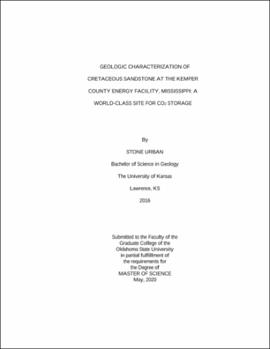| dc.contributor.advisor | Pashin, Jack | |
| dc.contributor.author | Urban, Stone | |
| dc.date.accessioned | 2020-09-09T20:58:51Z | |
| dc.date.available | 2020-09-09T20:58:51Z | |
| dc.date.issued | 2020-05 | |
| dc.identifier.uri | https://hdl.handle.net/11244/325467 | |
| dc.description.abstract | With anthropogenic CO2 being of growing concern, the Department of Energy's Carbon Storage Assurance Facility Enterprise (CarbonSAFE) program is designed to explore the possibility of saline storage of CO2 at and around the Kemper County, energy facility in east-central Mississippi. The natural gas combined cycle (NGCC) generation facility rests upon a thick succession of Mesozoic strata that contains numerous saline reservoirs that hold significant potential for carbon sequestration. To further characterize these reservoirs and evaluate their storage capacity, an integrated approach was used combining data from cores and geophysical well logs. | |
| dc.description.abstract | Mesozoic strata thicken to the southwest and unconformably overlie Paleozoic strata in Kemper County. Cretaceous units, such as the Paluxy Formation, Washita-Fredericksburg interval, and the lower Tuscaloosa Group are lithologically similar in that they are composed of sandstone and conglomerate that fine upward into interbedded sandstone and mudrock. Furthermore, the sandstone units contain saline water (>10,000 mg/L TDS), have high porosity (~30%), and have Darcy-class permeability making them particularly attractive for geologic storage. | |
| dc.description.abstract | To better understand sediment provenance and reservoir quality, petrologic analysis was used to determine framework grain composition, which was then plotted on Dickinson provenance diagrams. Furthermore, petrologic analysis was used to document diagenetic alterations and the resulting sedimentary fabrics influencing porosity. Lastly, geophysical well logs were used to identify reservoir quality packages using gamma ray and porosity cutoffs of ≤ 75 API units and ≥ 15%, respectively. The resulting net reservoir sandstone thickness and average porosity values for selected reservoirs was mapped and used to calculate CO2 storage capacity. | |
| dc.description.abstract | Results from routine core analysis suggest that Cretaceous sandstone was deposited as channel and bar deposits in bedload-dominated fluvial systems. Subsequent bifurcation of channels left deposits stranded and subaerially exposed, thus allowing vegetation, burrowing, and feldspar dissolution to occur. Significant feldspar dissolution created an abundance of secondary porosity in the form of moldic and oversized pores and left behind only minor amounts of pore-filling kaolinite. Ultimately, this enhanced the original porosity and permeability of sandstone reservoirs resulting in a P50 storage resource of 428 Mt in the Paluxy Formation, 753 Mt in the Washita-Fredericksburg interval, and 182 Mt in the lower Tuscaloosa Group. | |
| dc.format | application/pdf | |
| dc.language | en_US | |
| dc.rights | Copyright is held by the author who has granted the Oklahoma State University Library the non-exclusive right to share this material in its institutional repository. Contact Digital Library Services at lib-dls@okstate.edu or 405-744-9161 for the permission policy on the use, reproduction or distribution of this material. | |
| dc.title | Geologic characterization of cretaceous sandstone at the Kemper County energy facility, Mississippi: A world-class site for CO2 storage | |
| dc.contributor.committeeMember | Puckette, James | |
| dc.contributor.committeeMember | Hileman, Mary | |
| osu.filename | Urban_okstate_0664M_16627.pdf | |
| osu.accesstype | Open Access | |
| dc.type.genre | Thesis | |
| dc.type.material | Text | |
| thesis.degree.discipline | Geology | |
| thesis.degree.grantor | Oklahoma State University | |
